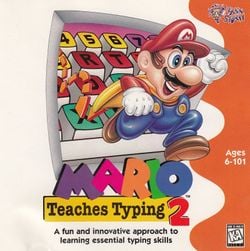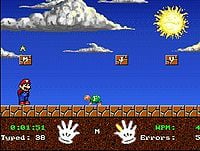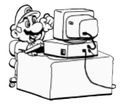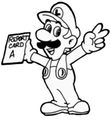Mario Teaches Typing 2: Difference between revisions
m (Text replacement - "(\[\[Category:[^\]\|\n]+[^tcr]) Games(\]|\|)" to "$1 games$2") |
(→Media) |
||
| (40 intermediate revisions by 18 users not shown) | |||
| Line 1: | Line 1: | ||
{{italic title}} | {{italic title}} | ||
{{more images}} | {{more images|More gameplay and interface screenshots}} | ||
{{ | {{game infobox | ||
|image=[[File:MarioTeachesTyping2Boxart.jpg|250px]] | |image=[[File:MarioTeachesTyping2Boxart.jpg|250px]] | ||
|developer=[[Interplay|Interplay Productions]]<br>Brainstorm Entertainment (PC) | |developer=[[Interplay|Interplay Productions]]<br>Brainstorm Entertainment (PC) | ||
|publisher=Interplay Productions | |publisher=Interplay Productions | ||
| | |release={{release|USA|October 31, 1996}} | ||
|genre=[[Genre#Edutainment|Educational]] | |genre=[[Genre#Edutainment|Educational]] | ||
|modes=Single | |modes=Single player | ||
|ratings={{ratings|esrb=K-A}} | |ratings={{ratings|esrb=K-A}} | ||
|platforms={{wp|Microsoft Windows}}, {{wp|Mac OS}} | |platforms={{wp|Microsoft Windows}}, {{wp|Mac OS}} | ||
| Line 13: | Line 13: | ||
|input={{input|pckeyb=1}} | |input={{input|pckeyb=1}} | ||
}} | }} | ||
[[File:MTT2 Win16 Icon.png|thumb| | [[File:MTT2 Win16 Icon.png|thumb|Game icon|left]] | ||
'''''Mario Teaches Typing 2''''' is the sequel to ''[[Mario Teaches Typing]]''. | '''''Mario Teaches Typing 2''''' is the sequel to ''[[Mario Teaches Typing]]'', an [[Genre#Edutainment|edutainment]] game produced for personal computers by [[Interplay|Interplay Productions]] under license from [[Nintendo]]. This sequel was released for PCs that supported {{wp|Microsoft Windows}} and {{wp| Classic Mac OS|Mac System software}} computers on October 31, 1996,<ref>[http://www.faqs.org/copyright/mario-teaches-typing-2-teacher-tribrid/ FAQs.org: Mario teaches typing 2 (teacher)-DOS] "''Date of Recordation: October 31, 1996''" (Retrieved March 12, 2011)</ref> Though a sequel by name, the game acts as more of a polished re-release of the CD-ROM Windows/Mac version of ''Mario Teaches Typing'', with some key differences; namely, brand-new cutscenes have been added between the levels to tell a more thorough and consequential story, the main menu is altered, with a primarily blue color scheme as opposed to the purple scheme in the first title, and the practice mode has been completely overhauled. In addition to these changes, additional gameplay features have been added, including a customizable certificate of achievement, a keyboard which is color-coded on screen for the player's reference, and customizable lesson plans. | ||
This is also the last [[Genre#Educational|educational]] ''[[Super Mario (franchise)|Super Mario]]'' game to be released. As the ''Super Mario''-themed educational titles were regarded as of lower quality compared to main series titles, [[Shigeru Miyamoto]] made clear to Brian Fargo, the CEO of Interplay Productions, that the company would no longer be permitted to use the Mario character for the edutainment genre; from then on, no further ''Super Mario'' games in the genre were produced.<ref>Osborn, Alex (June 20, 2017). [https://www.ign.com/articles/2017/06/20/interplay-founder-on-working-with-nintendo-on-mario-teaches-typing-a-ign-unfiltered Interplay Founder on Working With Nintendo on Mario Teaches Typing — IGN Unfiltered]. ''IGN''. Retrieved May 9, 2023.</ref> | |||
{{br|left}} | {{br|left}} | ||
| Line 20: | Line 22: | ||
The Windows version of the game can be installed and will work on {{wp|Windows 3.1}}, {{wp|Windows NT 3.1}}/{{wp|Windows NT 3.5|3.5}}/{{wp|Windows NT 3.51|3.51}}, {{wp|Windows 95}}, {{wp|Windows NT 4.0}}, {{wp|Windows 98}}/{{wp|Windows Millennium Edition|Me}}, {{wp|Windows 2000}}, and {{wp|Windows XP}}/{{wp|Windows Server 2003|Server 2003}} (32-bit versions only; the 64-bit versions for both Intel Itanium- and X86-64 (AMD64)-based systems do not work as they lack both the {{wp|Virtual DOS machine#NTVDM|NTVDM}} and the {{wp|Windows on Windows|WOW}} subsystem to play it{{footnote|main|1}}). It will not work in 32-bit installations of {{wp|Windows Vista}} as it will have problems installing. The program will install correctly in 32-bit installations of {{wp|Windows 7}} even without graphics card drivers. The game, however, is back to being broken in 32-bit versions of {{wp|Windows 8}}/{{wp|Windows 8.1|8.1}} and {{wp|Windows 10}} even if it is installed using compatibility settings. | The Windows version of the game can be installed and will work on {{wp|Windows 3.1}}, {{wp|Windows NT 3.1}}/{{wp|Windows NT 3.5|3.5}}/{{wp|Windows NT 3.51|3.51}}, {{wp|Windows 95}}, {{wp|Windows NT 4.0}}, {{wp|Windows 98}}/{{wp|Windows Millennium Edition|Me}}, {{wp|Windows 2000}}, and {{wp|Windows XP}}/{{wp|Windows Server 2003|Server 2003}} (32-bit versions only; the 64-bit versions for both Intel Itanium- and X86-64 (AMD64)-based systems do not work as they lack both the {{wp|Virtual DOS machine#NTVDM|NTVDM}} and the {{wp|Windows on Windows|WOW}} subsystem to play it{{footnote|main|1}}). It will not work in 32-bit installations of {{wp|Windows Vista}} as it will have problems installing. The program will install correctly in 32-bit installations of {{wp|Windows 7}} even without graphics card drivers. The game, however, is back to being broken in 32-bit versions of {{wp|Windows 8}}/{{wp|Windows 8.1|8.1}} and {{wp|Windows 10}} even if it is installed using compatibility settings. | ||
The {{wp|Mac OS}} version will work on {{wp|System 7}} all the way up to {{wp|Mac OS 9}}. Compatibility is not guaranteed under the Classic environment of PowerPC versions of {{wp|Mac OS X}} up until {{wp|Mac OS X Tiger}}, as {{wp|Mac OS X Leopard}} removed the Classic environment for PowerPC based systems. It will not run on Intel-based Macs or the latest Apple Silicon Macs due to their inability to run Mac OS 9 and below which is required to run pre-Carbon applications on Mac OS X/macOS as Rosetta (used in Intel versions of Mac OS X Tiger up until {{wp|Mac OS X Snow Leopard}} which runs exclusively on X86) only supports PowerPC Mac OS X applications and Rosetta 2 (used in {{wp|macOS Big Sur}}) will only run X86 Mac apps. Modern Mac users however can use programs like SheepShaver or Basilisk II which emulate older Macs that use Motorola 68000 or PowerPC-based Macs. Users of Intel-based Macs produced between 2006-2011 can also install Windows XP or a 32-bit version of Windows 7 using Bootcamp and run the Windows version of the game. | The {{wp|Mac OS}} version will work on {{wp|System 7}} all the way up to {{wp|Mac OS 9}}. Compatibility is not guaranteed under the Classic environment of PowerPC versions of {{wp|Mac OS X 10.0}} up until {{wp|Mac OS X Tiger}}, as {{wp|Mac OS X Leopard}} removed the Classic environment for PowerPC based systems. It will not run on Intel-based Macs or the latest Apple Silicon Macs due to their inability to run Mac OS 9 and below which is required to run pre-Carbon applications on Mac OS X/macOS as Rosetta (used in Intel versions of Mac OS X Tiger up until {{wp|Mac OS X Snow Leopard}} which runs exclusively on X86) only supports PowerPC Mac OS X applications and Rosetta 2 (used in {{wp|macOS Big Sur}}) will only run X86 Mac apps. Modern Mac users however can use programs like SheepShaver or Basilisk II which emulate older Macs that use Motorola 68000 or PowerPC-based Macs. Users of Intel-based Macs produced between 2006-2011 can also install Windows XP or a 32-bit version of Windows 7 using Bootcamp and run the Windows version of the game. | ||
{{footnote|note|1|In the case of Windows XP, only the Professional edition has a 64-bit version as all of the other editions such as Home Edition, Tablet PC Edition, Media Center Edition, etc. are 32-bit only for X86 based systems. There are two versions of Windows XP for Itanium-based systems: Version 2002 (based on the same Windows NT 5.1 codebase as the regular XP for IA-32 (32-bit X86) based systems) and Version 2003 (built on the Windows NT 5.2 codebase used in Windows Server 2003). {{wp|Windows XP Professional X64 Edition}} for AMD64 (x86-64) based systems is also built from the NT 5.2 (Server 2003) codebase, but with Service Pack 1 already incorporated. This limitation (of not being able to run 16-bit Windows applications on 64-bit Windows) is also carried over to versions past XP/Server 2003 such as Vista, 7, 8/8.1, and 10 (for both AMD64 and ARM64 based systems). Workarounds, however, do exist to get 16-bit Windows applications running on 64-bit Windows versions.}} | {{footnote|note|1|In the case of Windows XP, only the Professional edition has a 64-bit version as all of the other editions such as Home Edition, Tablet PC Edition, Media Center Edition, etc. are 32-bit only for X86 based systems. There are two versions of Windows XP for Itanium-based systems: Version 2002 (based on the same Windows NT 5.1 codebase as the regular XP for IA-32 (32-bit X86) based systems) and Version 2003 (built on the Windows NT 5.2 codebase used in Windows Server 2003). {{wp|Windows XP Professional X64 Edition}} for AMD64 (x86-64) based systems is also built from the NT 5.2 (Server 2003) codebase, but with Service Pack 1 already incorporated. This limitation (of not being able to run 16-bit Windows applications on 64-bit Windows) is also carried over to versions past XP/Server 2003 such as Vista, 7, 8/8.1, and 10 (for both AMD64 and ARM64 based systems). Workarounds, however, do exist to get 16-bit Windows applications running on 64-bit Windows versions.}} | ||
| Line 39: | Line 41: | ||
Mario and Luigi, in their snorkels, dive to a sunken ship in the river, taking the typewriter piece from a sleeping octopus. However, the octopus awakens and chases the brothers, though they escape through the ship's windows. | Mario and Luigi, in their snorkels, dive to a sunken ship in the river, taking the typewriter piece from a sleeping octopus. However, the octopus awakens and chases the brothers, though they escape through the ship's windows. | ||
Mario and Luigi then walk up to Bowser's Castle and knock on the door. They are surprised when the castle turns out to be alive, and swallows them. Mario and Luigi run into several traps until finally defeating some Koopas playing poker for the final typewriter piece. The brothers then escape from the castle, and Mario types on the restored typewriter: | Mario and Luigi then walk up to Bowser's Castle and knock on the door. They are surprised when the castle turns out to be alive, and swallows them. Mario and Luigi run into several traps such as falling [[Thwomp]]s until finally defeating some Koopas playing poker for the final typewriter piece. The brothers then escape from the castle, and Mario types on the restored typewriter: | ||
:<font face="Times New Roman">Koopa Troopa paratroopa Bowser's Castle go kablooka!</font> | :<font face="Times New Roman">Koopa Troopa paratroopa Bowser's Castle go kablooka!</font> | ||
| Line 62: | Line 64: | ||
|title4=Mario flies for the player, then crashes and hits his nose. | |title4=Mario flies for the player, then crashes and hits his nose. | ||
|file5=MTT2 - Mario Admires the Computer.oga | |file5=MTT2 - Mario Admires the Computer.oga | ||
|title5=Mario admires the computer. | |title5=Mario admires the player's computer, and asks them if he can have it. | ||
|file6=MTT2 - Mario Says Goodbye.oga | |file6=MTT2 - Mario Says Goodbye.oga | ||
|title6=Mario says bye to the player. | |title6=Mario says bye to the player. | ||
| Line 68: | Line 70: | ||
==Gallery== | ==Gallery== | ||
===Screenshots=== | |||
<gallery> | |||
MTTyping4.png|Title screen | |||
Mario Teaches Typing 2 Windows.png|Windows Main Screen | |||
MTTyping21.png|Main menu | |||
MTTyping3.png|Cutscene | |||
MTTyping22.png|Cutscene | |||
</gallery> | |||
===Artwork=== | |||
<gallery> | <gallery> | ||
MTT2Art.png|Mario, on a computer | MTT2Art.png|Mario, on a computer | ||
| Line 80: | Line 92: | ||
==Trivia== | ==Trivia== | ||
*Mario's "I'm a videogame!" routine involves bouncing across the screen and making simplistic noises when hitting the sides, imitating ''{{wp|Pong}}'', an early arcade game. | *Mario's "I'm a videogame!" routine involves bouncing across the screen and making simplistic noises when hitting the sides, imitating ''{{wp|Pong}}'', an early arcade game. | ||
* The Koopa Troopas playing poker in Bowser's Castle is based on the painting ''{{wp|Dogs Playing Poker}}''. | |||
==References== | ==References== | ||
<references/> | <references/> | ||
{{ | {{Super Mario games}} | ||
{{ | {{Computer}} | ||
[[de:Mario Teaches Typing 2]] | [[de:Mario Teaches Typing 2]] | ||
[[Category:Mario Teaches Typing 2|*]] | [[Category:Mario Teaches Typing 2|*]] | ||
[[Category:Games]] | [[Category:Games]] | ||
[[Category: | [[Category:Educational games]] | ||
[[Category:1996 games]] | [[Category:1996 games]] | ||
[[Category: | [[Category:Windows games]] | ||
Latest revision as of 18:48, April 1, 2024
It has been requested that more images be uploaded for this article. Remove this notice only after the additional image(s) have been added. Reason: More gameplay and interface screenshots
| Mario Teaches Typing 2 | |||
|---|---|---|---|

| |||
| Developer | Interplay Productions Brainstorm Entertainment (PC) | ||
| Publisher | Interplay Productions | ||
| Platform(s) | Microsoft Windows, Mac OS | ||
| Release date | |||
| Genre | Educational | ||
| Rating(s) |
| ||
| Mode(s) | Single player | ||
| Media | Home computer system:
| ||
| Input | Home computer system:
| ||
Mario Teaches Typing 2 is the sequel to Mario Teaches Typing, an edutainment game produced for personal computers by Interplay Productions under license from Nintendo. This sequel was released for PCs that supported Microsoft Windows and Mac System software computers on October 31, 1996,[1] Though a sequel by name, the game acts as more of a polished re-release of the CD-ROM Windows/Mac version of Mario Teaches Typing, with some key differences; namely, brand-new cutscenes have been added between the levels to tell a more thorough and consequential story, the main menu is altered, with a primarily blue color scheme as opposed to the purple scheme in the first title, and the practice mode has been completely overhauled. In addition to these changes, additional gameplay features have been added, including a customizable certificate of achievement, a keyboard which is color-coded on screen for the player's reference, and customizable lesson plans.
This is also the last educational Super Mario game to be released. As the Super Mario-themed educational titles were regarded as of lower quality compared to main series titles, Shigeru Miyamoto made clear to Brian Fargo, the CEO of Interplay Productions, that the company would no longer be permitted to use the Mario character for the edutainment genre; from then on, no further Super Mario games in the genre were produced.[2]
Compatibility[edit]
The Windows version of the game can be installed and will work on Windows 3.1, Windows NT 3.1/3.5/3.51, Windows 95, Windows NT 4.0, Windows 98/Me, Windows 2000, and Windows XP/Server 2003 (32-bit versions only; the 64-bit versions for both Intel Itanium- and X86-64 (AMD64)-based systems do not work as they lack both the NTVDM and the WOW subsystem to play it1). It will not work in 32-bit installations of Windows Vista as it will have problems installing. The program will install correctly in 32-bit installations of Windows 7 even without graphics card drivers. The game, however, is back to being broken in 32-bit versions of Windows 8/8.1 and Windows 10 even if it is installed using compatibility settings.
The Mac OS version will work on System 7 all the way up to Mac OS 9. Compatibility is not guaranteed under the Classic environment of PowerPC versions of Mac OS X 10.0 up until Mac OS X Tiger, as Mac OS X Leopard removed the Classic environment for PowerPC based systems. It will not run on Intel-based Macs or the latest Apple Silicon Macs due to their inability to run Mac OS 9 and below which is required to run pre-Carbon applications on Mac OS X/macOS as Rosetta (used in Intel versions of Mac OS X Tiger up until Mac OS X Snow Leopard which runs exclusively on X86) only supports PowerPC Mac OS X applications and Rosetta 2 (used in macOS Big Sur) will only run X86 Mac apps. Modern Mac users however can use programs like SheepShaver or Basilisk II which emulate older Macs that use Motorola 68000 or PowerPC-based Macs. Users of Intel-based Macs produced between 2006-2011 can also install Windows XP or a 32-bit version of Windows 7 using Bootcamp and run the Windows version of the game.
1 - In the case of Windows XP, only the Professional edition has a 64-bit version as all of the other editions such as Home Edition, Tablet PC Edition, Media Center Edition, etc. are 32-bit only for X86 based systems. There are two versions of Windows XP for Itanium-based systems: Version 2002 (based on the same Windows NT 5.1 codebase as the regular XP for IA-32 (32-bit X86) based systems) and Version 2003 (built on the Windows NT 5.2 codebase used in Windows Server 2003). Windows XP Professional X64 Edition for AMD64 (x86-64) based systems is also built from the NT 5.2 (Server 2003) codebase, but with Service Pack 1 already incorporated. This limitation (of not being able to run 16-bit Windows applications on 64-bit Windows) is also carried over to versions past XP/Server 2003 such as Vista, 7, 8/8.1, and 10 (for both AMD64 and ARM64 based systems). Workarounds, however, do exist to get 16-bit Windows applications running on 64-bit Windows versions.
Story[edit]
Mario and Luigi are walking by Bowser's Castle when a mysterious typewriter suddenly appears in front of them. To their amazement, the typewriter starts typing by itself. When it is finished, Mario takes the paper out of the typewriter, causing it to transform into a scroll. The scroll reads:
"The Magical Typewriter is the key to beating Bowser. You must type the magic words onto the scroll to cast the spell which will destroy Bowser's Castle.
"Be forewarned, however, that if the magic words are not typed exactly, the Magical Typewriter will self-destruct into pieces."
The Magical Typewriter then floats in front of Mario. Mario pockets the scroll and types:
- Koooppa tTrupa pparraTroopaa Bbow
Before Mario can go on any further, the Magical Typewriter explodes into three pieces, which land in different places: one into a river, another somewhere on Mario and Luigi's side of the river, and the last one on the other side of the river. Mario and Luigi decide to recover all of the pieces and improve Mario's typing skills in order to type the spell correctly and ensure their victory.
As Mario and Luigi get the first piece from a dim Koopa Troopa, a Red Koopa Troopa detonates the river bridge with TNT and takes one of the pieces back to Bowser's Castle. Mario then dons a snorkel and dives into the river, attempting to get the piece that fell into it. Luigi goes in also after defeating some Cheep Cheeps that are attacking Mario.
Mario and Luigi, in their snorkels, dive to a sunken ship in the river, taking the typewriter piece from a sleeping octopus. However, the octopus awakens and chases the brothers, though they escape through the ship's windows.
Mario and Luigi then walk up to Bowser's Castle and knock on the door. They are surprised when the castle turns out to be alive, and swallows them. Mario and Luigi run into several traps such as falling Thwomps until finally defeating some Koopas playing poker for the final typewriter piece. The brothers then escape from the castle, and Mario types on the restored typewriter:
- Koopa Troopa paratroopa Bowser's Castle go kablooka!
A giant typewriter suddenly falls from the sky and destroys Bowser's Castle. Mario and Luigi celebrate.
Levels[edit]
- Mario's Smash and Dash - for beginners.
- Mario's Wet World Challenge - for the intermediate typers.
- Mario's Tunnel of Doom - for the advanced players.
- Mario's Expert Express - the hardest level.
Media[edit]
| File info |
| File info |
| File info |
| File info |
| File info |
| File info |
Gallery[edit]
Screenshots[edit]
Artwork[edit]
Mario, Luigi and the Princess with a key
Staff[edit]
- Main article: List of Mario Teaches Typing 2 staff
Trivia[edit]
- Mario's "I'm a videogame!" routine involves bouncing across the screen and making simplistic noises when hitting the sides, imitating Pong, an early arcade game.
- The Koopa Troopas playing poker in Bowser's Castle is based on the painting Dogs Playing Poker.
References[edit]
- ^ FAQs.org: Mario teaches typing 2 (teacher)-DOS "Date of Recordation: October 31, 1996" (Retrieved March 12, 2011)
- ^ Osborn, Alex (June 20, 2017). Interplay Founder on Working With Nintendo on Mario Teaches Typing — IGN Unfiltered. IGN. Retrieved May 9, 2023.









